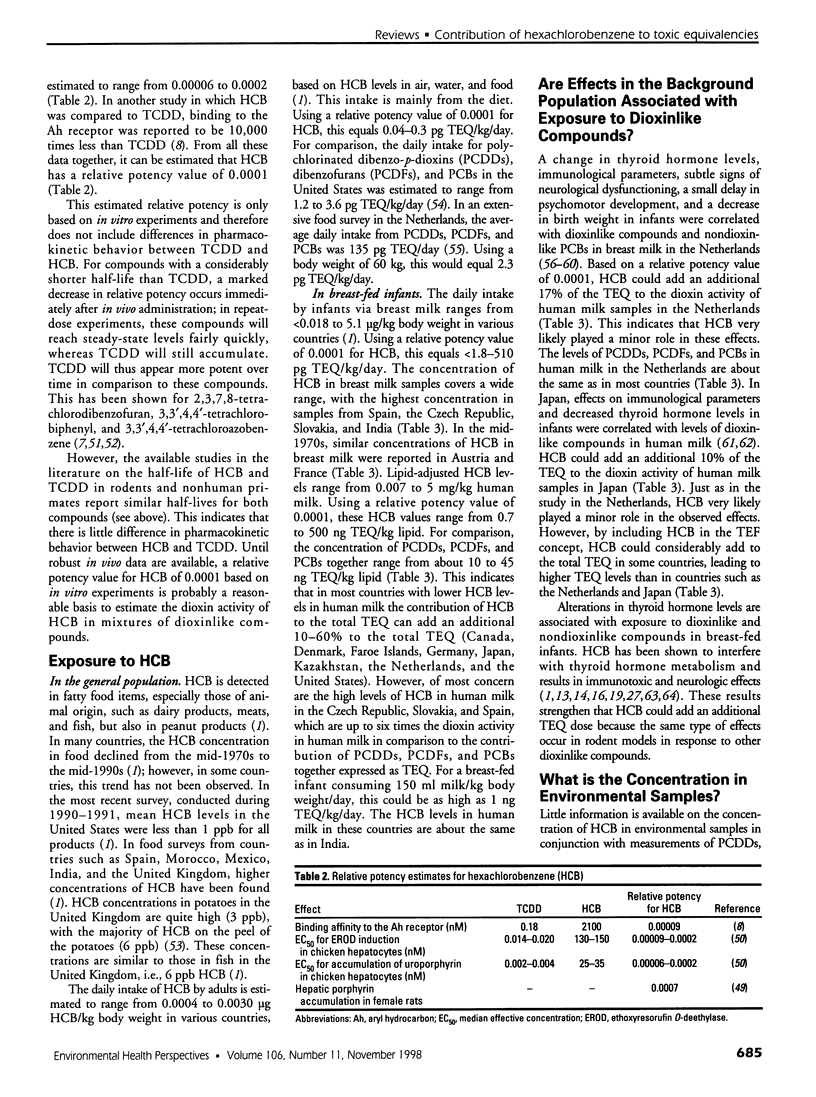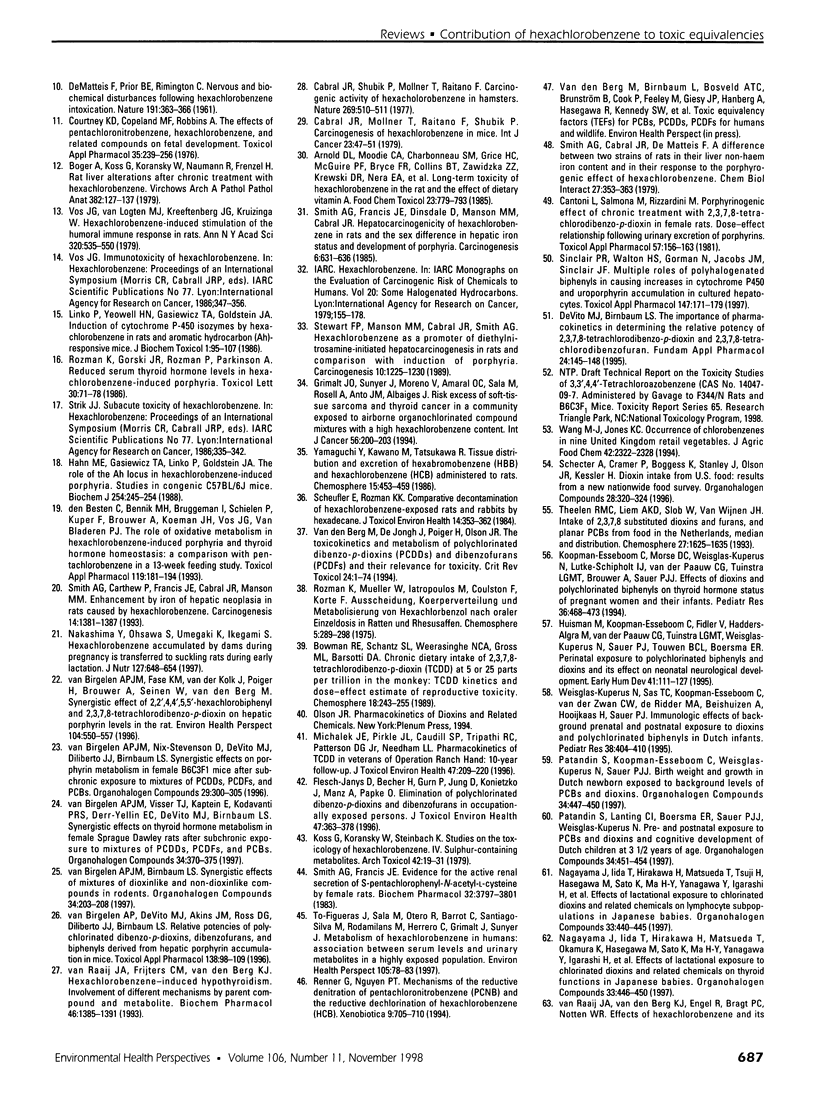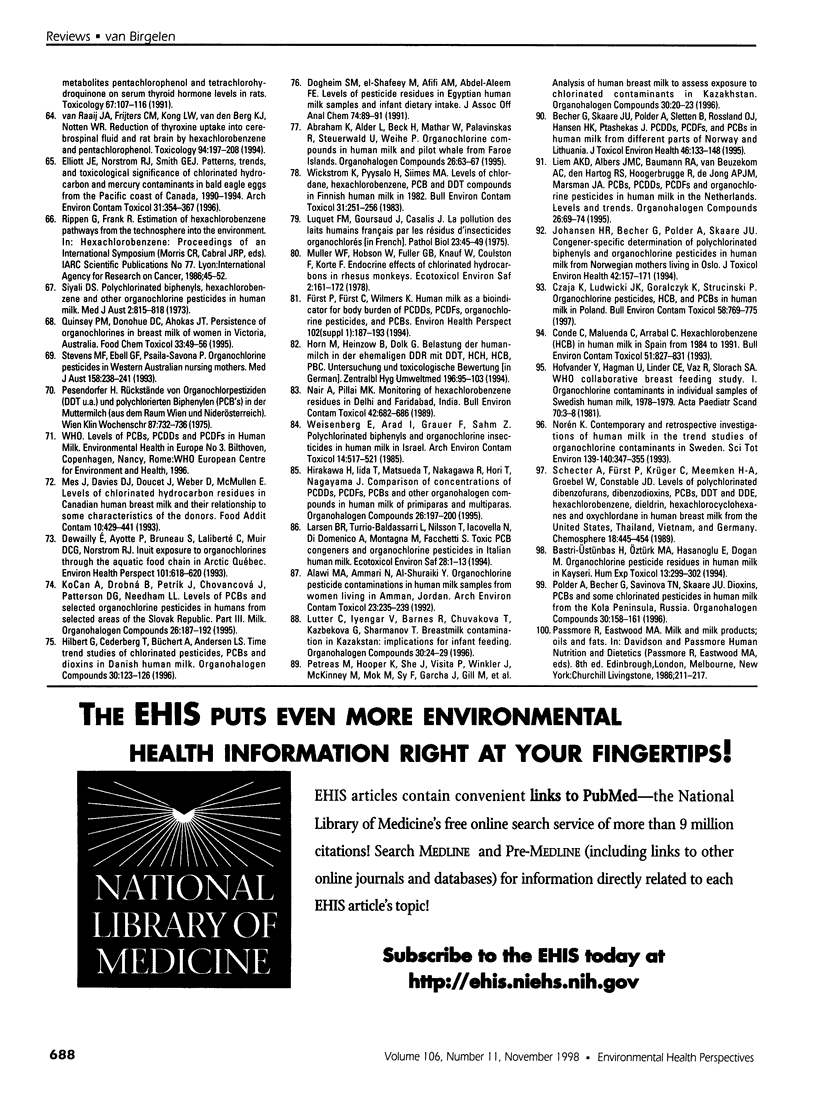Abstract
A dioxinlike compound is a compound that binds to the aryl hydrocarbon (Ah) receptor, results in dioxinlike effects, and bioaccumulates. These are the three factors for including dioxinlike chemicals in the toxic equivalency factor (TEF) concept. Risk assessment of dioxinlike compounds is based on using these TEFs. Hexachlorobenzene (HCB) has all three features and should therefore be included in this TEF concept. Relative potency values express the potency of a specific compound in comparison to 2,3,7, 8-tetrachlorodibenzo-p-dioxin (TCDD), the most potent dioxinlike compound, with a relative potency value of 1. For the estimation of the total dioxin activity in an environmental biological sample, the TEF value of a compound is multiplied by the concentration in the specific matrix. This results in a certain amount of toxic equivalents (TEQs) for this compound. The summation of all TEQs in a certain mixture gives the total dioxin activity of this mixture. HCB binds to the Ah receptor about 10,000 times less than TCDD. HCB is also about 10,000 times less potent than TCDD based on in vitro cytochrome P4501A induction and porphyrin accumulation. Using a relative potency value of 0.0001, HCB could add 10-60% to the total TEQ in human milk samples in most countries. In a few countries such as Spain, Slovakia, and the Czech Republic, HCB levels in human milk expressed as TEQ could contribute up to a factor of six to the total TEQ in comparison to the contribution of polychlorinated dioxins, dibenzofurans, and biphenyls together, i.e., up to a daily intake of about 1 ng TEQ/kg for a breast-fed infant. The HCB levels in human milk in these countries are about the same as in India. Biochemical, immunological, and neurological alterations have been observed in infants fed breast milk in countries with relatively low TEQ levels in human milk. Based on the above information, it is clear that HCB should be classified as a dioxinlike compound, that more studies are needed to reduce the uncertainty in the estimation of a relative potency value for HCB, and that epidemiological studies should be undertaken in infants fed breast milk in countries with high HCB exposure levels. Furthermore, measurements of HCB levels in human and environmental samples in conjunction with other dioxinlike compounds is a prerequisite to estimate the total dioxin activity in these samples.
Full text
PDF





Selected References
These references are in PubMed. This may not be the complete list of references from this article.
- Ahlborg U. G., Brouwer A., Fingerhut M. A., Jacobson J. L., Jacobson S. W., Kennedy S. W., Kettrup A. A., Koeman J. H., Poiger H., Rappe C. Impact of polychlorinated dibenzo-p-dioxins, dibenzofurans, and biphenyls on human and environmental health, with special emphasis on application of the toxic equivalency factor concept. Eur J Pharmacol. 1992 Dec 1;228(4):179–199. doi: 10.1016/0926-6917(92)90029-c. [DOI] [PubMed] [Google Scholar]
- Alawi M. A., Ammari N., al-Shuraiki Y. Organochlorine pesticide contaminations in human milk samples from women living in Amman, Jordan. Arch Environ Contam Toxicol. 1992 Aug;23(2):235–239. doi: 10.1007/BF00212281. [DOI] [PubMed] [Google Scholar]
- Arnold D. L., Moodie C. A., Charbonneau S. M., Grice H. C., McGuire P. F., Bryce F. R., Collins B. T., Zawidzka Z. Z., Krewski D. R., Nera E. A. Long-term toxicity of hexachlorobenzene in the rat and the effect of dietary vitamin A. Food Chem Toxicol. 1985 Sep;23(9):779–793. doi: 10.1016/0278-6915(85)90278-9. [DOI] [PubMed] [Google Scholar]
- Basri Ustünbas H., Oztürk M. A., Hasanoğlu E., Doğan M. Organochlorine pesticide residues in human milk in Kayseri. Hum Exp Toxicol. 1994 May;13(5):299–302. doi: 10.1177/096032719401300501. [DOI] [PubMed] [Google Scholar]
- Becher G., Skaare J. U., Polder A., Sletten B., Rossland O. J., Hansen H. K., Ptashekas J. PCDDs, PCDFs, and PCBs in human milk from different parts of Norway and Lithuania. J Toxicol Environ Health. 1995 Oct;46(2):133–148. doi: 10.1080/15287399509532024. [DOI] [PubMed] [Google Scholar]
- Böger A., Koss G., Koransky W., Naumann R., Frenzel H. Rat liver alterations after chronic treatment with hexachlorobenzene. Virchows Arch A Pathol Anat Histol. 1979 May 31;382(2):127–137. doi: 10.1007/BF01102869. [DOI] [PubMed] [Google Scholar]
- Cabral J. R., Mollner T., Raitano F., Shubik P. Carcinogenesis of hexachlorobenzene in mice. Int J Cancer. 1979 Jan 15;23(1):47–51. doi: 10.1002/ijc.2910230110. [DOI] [PubMed] [Google Scholar]
- Cabral J. R., Shubik P., Mollner T., Raitano F. Carcinogenic activity of hexacholorobenzene in hamsters. Nature. 1977 Oct 6;269(5628):510–511. doi: 10.1038/269510a0. [DOI] [PubMed] [Google Scholar]
- Cantoni L., Salmona M., Rizzardini M. Porphyrogenic effect of chronic treatment with 2,3,7,8-tetrachlorodibenzo-p-dioxin in female rats. Dose--effect relationship following urinary excretion of porphyrins. Toxicol Appl Pharmacol. 1981 Feb;57(2):156–163. doi: 10.1016/0041-008x(81)90275-1. [DOI] [PubMed] [Google Scholar]
- Conde C., Maluenda C., Arrabal C. Hexachlorobenzene (HCB) in human milk in Spain from 1984 to 1991. Bull Environ Contam Toxicol. 1993 Dec;51(6):827–831. doi: 10.1007/BF00198277. [DOI] [PubMed] [Google Scholar]
- Courtney K. D., Copeland M. F., Robbins A. The effects of pentachloronitrobenzene, hexachlorobenzene, and related compounds on fetal development. Toxicol Appl Pharmacol. 1976 Feb;35(2):239–256. doi: 10.1016/0041-008x(76)90285-4. [DOI] [PubMed] [Google Scholar]
- Czaja K., Ludwicki J. K., Góralczyk K., Strucinski P. Organochlorine pesticides, HCB, and PCBs in human milk in Poland. Bull Environ Contam Toxicol. 1997 May;58(5):769–775. doi: 10.1007/s001289900400. [DOI] [PubMed] [Google Scholar]
- DE MATTEIS F., PRIOR B. E., RIMINGTON C. Nervous and biochemical disturbances following hexachlorobenzene intoxication. Nature. 1961 Jul 22;191:363–366. doi: 10.1038/191363a0. [DOI] [PubMed] [Google Scholar]
- DeVito M. J., Birnbaum L. S. The importance of pharmacokinetics in determining the relative potency of 2,3,7,8-tetrachlorodibenzo-p-dioxin and 2,3,7,8-tetrachlorodibenzofuran. Fundam Appl Toxicol. 1995 Jan;24(1):145–148. doi: 10.1006/faat.1995.1016. [DOI] [PubMed] [Google Scholar]
- Dewailly E., Ayotte P., Bruneau S., Laliberté C., Muir D. C., Norstrom R. J. Inuit exposure to organochlorines through the aquatic food chain in arctic québec. Environ Health Perspect. 1993 Dec;101(7):618–620. doi: 10.1289/ehp.93101618. [DOI] [PMC free article] [PubMed] [Google Scholar]
- Dogheim S. M., el-Shafeey M., Afifi A. M., Abdel-Aleem F. E. Levels of pesticide residues in Egyptian human milk samples and infant dietary intake. J Assoc Off Anal Chem. 1991 Jan-Feb;74(1):89–91. [PubMed] [Google Scholar]
- Elliott J. E., Norstrom R. J., Smith G. E. Patterns, trends, and toxicological significance of chlorinated hydrocarbon and mercury contaminants in bald eagle eggs from the Pacific coast of Canada, 1990-1994. Arch Environ Contam Toxicol. 1996 Oct;31(3):354–367. doi: 10.1007/BF00212674. [DOI] [PubMed] [Google Scholar]
- Flesch-Janys D., Becher H., Gurn P., Jung D., Konietzko J., Manz A., Päpke O. Elimination of polychlorinated dibenzo-p-dioxins and dibenzofurans in occupationally exposed persons. J Toxicol Environ Health. 1996 Mar;47(4):363–378. doi: 10.1080/009841096161708. [DOI] [PubMed] [Google Scholar]
- Fürst P., Fürst C., Wilmers K. Human milk as a bioindicator for body burden of PCDDs, PCDFs, organochlorine pesticides, and PCBs. Environ Health Perspect. 1994 Jan;102 (Suppl 1):187–193. doi: 10.1289/ehp.102-1566908. [DOI] [PMC free article] [PubMed] [Google Scholar]
- Grimalt J. O., Sunyer J., Moreno V., Amaral O. C., Sala M., Rosell A., Anto J. M., Albaiges J. Risk excess of soft-tissue sarcoma and thyroid cancer in a community exposed to airborne organochlorinated compound mixtures with a high hexachlorobenzene content. Int J Cancer. 1994 Jan 15;56(2):200–203. doi: 10.1002/ijc.2910560209. [DOI] [PubMed] [Google Scholar]
- Hahn M. E., Gasiewicz T. A., Linko P., Goldstein J. A. The role of the Ah locus in hexachlorobenzene-induced porphyria. Studies in congenic C57BL/6J mice. Biochem J. 1988 Aug 15;254(1):245–254. doi: 10.1042/bj2540245. [DOI] [PMC free article] [PubMed] [Google Scholar]
- Hahn M. E., Goldstein J. A., Linko P., Gasiewicz T. A. Interaction of hexachlorobenzene with the receptor for 2,3,7,8-tetrachlorodibenzo-p-dioxin in vitro and in vivo. Evidence that hexachlorobenzene is a weak Ah receptor agonist. Arch Biochem Biophys. 1989 Apr;270(1):344–355. doi: 10.1016/0003-9861(89)90037-4. [DOI] [PubMed] [Google Scholar]
- Horn M., Heinzow B., Dolk G. Belastung der Humanmilch in der ehemaligen DDR mit DDT, HCH, HCB, PCB. Untersuchung und toxikologische Bewertung. Zentralbl Hyg Umweltmed. 1994 Aug;196(2):95–103. [PubMed] [Google Scholar]
- Johansen H. R., Becher G., Polder A., Skaare J. U. Congener-specific determination of polychlorinated biphenyls and organochlorine pesticides in human milk from Norwegian mothers living in Oslo. J Toxicol Environ Health. 1994 Jun;42(2):157–171. doi: 10.1080/15287399409531870. [DOI] [PubMed] [Google Scholar]
- Kafafi S. A., Afeefy H. Y., Ali A. H., Said H. K., Abd-Elazem I. S., Kafafi A. G. Affinities for the aryl hydrocarbon receptor, potencies as aryl hydrocarbon hydroxylase inducers and relative toxicities of polychlorinated biphenyls. A congener specific approach. Carcinogenesis. 1993 Oct;14(10):2063–2071. doi: 10.1093/carcin/14.10.2063. [DOI] [PubMed] [Google Scholar]
- Koopman-Esseboom C., Morse D. C., Weisglas-Kuperus N., Lutkeschipholt I. J., Van der Paauw C. G., Tuinstra L. G., Brouwer A., Sauer P. J. Effects of dioxins and polychlorinated biphenyls on thyroid hormone status of pregnant women and their infants. Pediatr Res. 1994 Oct;36(4):468–473. doi: 10.1203/00006450-199410000-00009. [DOI] [PubMed] [Google Scholar]
- Koss G., Koransky W., Steinbach K. Studies on the toxicology of hexachlorobenzene. IV. Sulphur-containing metabolites. Arch Toxicol. 1979 Apr 23;42(1):19–31. doi: 10.1007/BF00351821. [DOI] [PubMed] [Google Scholar]
- Larsen B. R., Turrio-Baldassarri L., Nilsson T., Iacovella N., Di Domenico A., Montagna M., Facchetti S. Toxic PCB congeners and organochlorine pesticides in Italian human milk. Ecotoxicol Environ Saf. 1994 Jun;28(1):1–13. doi: 10.1006/eesa.1994.1029. [DOI] [PubMed] [Google Scholar]
- Linko P., Yeowell H. N., Gasiewicz T. A., Goldstein J. A. Induction of cytochrome P-450 isozymes by hexachlorobenzene in rats and aromatic hydrocarbon (Ah)-responsive mice. J Biochem Toxicol. 1986 Jun;1(2):95–107. doi: 10.1002/jbt.2570010209. [DOI] [PubMed] [Google Scholar]
- Luquet F. M., Goursaud J., Casalis J. La pollution des laits humains français par les résidus d'insecticides organochlorés. Pathol Biol (Paris) 1975 Jan;23(1):45–49. [PubMed] [Google Scholar]
- Mes J., Davies D. J., Doucet J., Weber D., McMullen E. Levels of chlorinated hydrocarbon residues in Canadian human breast milk and their relationship to some characteristics of the donors. Food Addit Contam. 1993 Jul-Aug;10(4):429–441. doi: 10.1080/02652039309374166. [DOI] [PubMed] [Google Scholar]
- Michalek J. E., Pirkle J. L., Caudill S. P., Tripathi R. C., Patterson D. G., Jr, Needham L. L. Pharmacokinetics of TCDD in veterans of Operation Ranch Hand: 10-year follow-up. J Toxicol Environ Health. 1996 Feb 23;47(3):209–220. doi: 10.1080/009841096161744. [DOI] [PubMed] [Google Scholar]
- Müller W. F., Hobson W., Fuller G. B., Knauf W., Coulston F., Korte F. Endocrine effects of chlorinated hydrocarbons in rhesus monkeys. Ecotoxicol Environ Saf. 1978 Sep;2(2):161–172. doi: 10.1016/0147-6513(78)90007-6. [DOI] [PubMed] [Google Scholar]
- Nair A., Pillai M. K. Monitoring of hexachlorobenzene residues in Delhi and Faridabad, India. Bull Environ Contam Toxicol. 1989 May;42(5):682–686. doi: 10.1007/BF01700388. [DOI] [PubMed] [Google Scholar]
- Nakashima Y., Ohsawa S., Umegaki K., Ikegami S. Hexachlorobenzene accumulated by dams during pregnancy is transferred to suckling rats during early lactation. J Nutr. 1997 Apr;127(4):648–654. doi: 10.1093/jn/127.4.648. [DOI] [PubMed] [Google Scholar]
- Norén K. Contemporary and retrospective investigations of human milk in the trend studies of organochlorine contaminants in Sweden. Sci Total Environ. 1993 Nov 1;139-140:347–355. doi: 10.1016/0048-9697(93)90032-2. [DOI] [PubMed] [Google Scholar]
- Pesendorfer H. Rückstände von Organochlorpestiziden (DDT u.a.) und polychlorierten Biphenylen (PCB's) in der Muttermilch. Wien Klin Wochenschr. 1975 Nov 14;87(21):732–736. [PubMed] [Google Scholar]
- Quinsey P. M., Donohue D. C., Ahokas J. T. Persistence of organochlorines in breast milk of women in Victoria, Australia. Food Chem Toxicol. 1995 Jan;33(1):49–56. doi: 10.1016/0278-6915(95)80248-7. [DOI] [PubMed] [Google Scholar]
- Rozman K., Gorski J. R., Rozman P., Parkinson A. Reduced serum thyroid hormone levels in hexachlorobenzene-induced porphyria. Toxicol Lett. 1986 Jan;30(1):71–78. doi: 10.1016/0378-4274(86)90181-5. [DOI] [PubMed] [Google Scholar]
- Scheufler E., Rozman K. K. Comparative decontamination of hexachlorobenzene-exposed rats and rabbits by hexadecane. J Toxicol Environ Health. 1984;14(2-3):353–362. doi: 10.1080/15287398409530585. [DOI] [PubMed] [Google Scholar]
- Sinclair P. R., Walton H. S., Gorman N., Jacobs J. M., Sinclair J. F. Multiple roles of polyhalogenated biphenyls in causing increases in cytochrome P450 and uroporphyrin accumulation in cultured hepatocytes. Toxicol Appl Pharmacol. 1997 Dec;147(2):171–179. doi: 10.1006/taap.1997.8273. [DOI] [PubMed] [Google Scholar]
- Siyali D. S. Polychlorinated biphenyls, hexachlorobenzene and other organochlorine pesticides in human milk. Med J Aust. 1973 Oct 27;2(17):815–818. doi: 10.5694/j.1326-5377.1973.tb129783.x. [DOI] [PubMed] [Google Scholar]
- Smith A. G., Cabral J. R., De Matteis F. A difference between two strains of rats in their liver non-haem iron content and in their response to the porphyrogenic effect of hexachlorobenzene. Chem Biol Interact. 1979 Oct;27(2-3):353–363. doi: 10.1016/0009-2797(79)90138-8. [DOI] [PubMed] [Google Scholar]
- Smith A. G., Carthew P., Francis J. E., Cabral J. R., Manson M. M. Enhancement by iron of hepatic neoplasia in rats caused by hexachlorobenzene. Carcinogenesis. 1993 Jul;14(7):1381–1387. doi: 10.1093/carcin/14.7.1381. [DOI] [PubMed] [Google Scholar]
- Smith A. G., Francis J. E., Dinsdale D., Manson M. M., Cabral J. R. Hepatocarcinogenicity of hexachlorobenzene in rats and the sex difference in hepatic iron status and development of porphyria. Carcinogenesis. 1985 Apr;6(4):631–636. doi: 10.1093/carcin/6.4.631. [DOI] [PubMed] [Google Scholar]
- Smith A. G., Francis J. E. Evidence for the active renal secretion of S-pentachlorophenyl-N-acetyl-L-cysteine by female rats. Biochem Pharmacol. 1983 Dec 15;32(24):3797–3801. doi: 10.1016/0006-2952(83)90152-1. [DOI] [PubMed] [Google Scholar]
- Stewart F. P., Manson M. M., Cabral J. R., Smith A. G. Hexachlorobenzene as a promoter of diethylnitrosamine-initiated hepatocarcinogenesis in rats and comparison with induction of porphyria. Carcinogenesis. 1989 Jul;10(7):1225–1230. doi: 10.1093/carcin/10.7.1225. [DOI] [PubMed] [Google Scholar]
- To-Figueras J., Sala M., Otero R., Barrot C., Santiago-Silva M., Rodamilans M., Herrero C., Grimalt J., Sunyer J. Metabolism of hexachlorobenzene in humans: association between serum levels and urinary metabolites in a highly exposed population. Environ Health Perspect. 1997 Jan;105(1):78–83. doi: 10.1289/ehp.9710578. [DOI] [PMC free article] [PubMed] [Google Scholar]
- Van den Berg M., De Jongh J., Poiger H., Olson J. R. The toxicokinetics and metabolism of polychlorinated dibenzo-p-dioxins (PCDDs) and dibenzofurans (PCDFs) and their relevance for toxicity. Crit Rev Toxicol. 1994;24(1):1–74. doi: 10.3109/10408449409017919. [DOI] [PubMed] [Google Scholar]
- Vos J. G., van Logten M. J., Kreeftenberg J. G., Kruizinga W. Hexachlorobenzene-induced stimulation of the humoral immune response in rats. Ann N Y Acad Sci. 1979 May 31;320:535–550. [PubMed] [Google Scholar]
- Weisenberg E., Arad I., Grauer F., Sahm Z. Polychlorinated biphenyls and organochlorine insecticides in human milk in Israel. Arch Environ Contam Toxicol. 1985 Sep;14(5):517–521. doi: 10.1007/BF01055379. [DOI] [PubMed] [Google Scholar]
- Weisglas-Kuperus N., Sas T. C., Koopman-Esseboom C., van der Zwan C. W., De Ridder M. A., Beishuizen A., Hooijkaas H., Sauer P. J. Immunologic effects of background prenatal and postnatal exposure to dioxins and polychlorinated biphenyls in Dutch infants. Pediatr Res. 1995 Sep;38(3):404–410. doi: 10.1203/00006450-199509000-00022. [DOI] [PubMed] [Google Scholar]
- Wickström K., Pyysalo H., Siimes M. A. Levels of chlordane, hexachlorobenzene, PCB and DDT compounds in Finnish human milk in 1982. Bull Environ Contam Toxicol. 1983 Sep;31(3):251–256. doi: 10.1007/BF01608694. [DOI] [PubMed] [Google Scholar]
- den Besten C., Bennik M. H., Bruggeman I., Schielen P., Kuper F., Brouwer A., Koeman J. H., Vos J. G., Van Bladeren P. J. The role of oxidative metabolism in hexachlorobenzene-induced porphyria and thyroid hormone homeostasis: a comparison with pentachlorobenzene in a 13-week feeding study. Toxicol Appl Pharmacol. 1993 Apr;119(2):181–194. doi: 10.1006/taap.1993.1059. [DOI] [PubMed] [Google Scholar]
- van Birgelen A. P., DeVito M. J., Akins J. M., Ross D. G., Diliberto J. J., Birnbaum L. S. Relative potencies of polychlorinated dibenzo-p-dioxins, dibenzofurans, and biphenyls derived from hepatic porphyrin accumulation in mice. Toxicol Appl Pharmacol. 1996 May;138(1):98–109. doi: 10.1006/taap.1996.0103. [DOI] [PubMed] [Google Scholar]
- van Birgelen A. P., Fase K. M., van der Kolk J., Poiger H., Brouwer A., Seinen W., van den Berg M. Synergistic effect of 2,2',4,4',5,5'-hexachlorobiphenyl and 2,3,7,8-tetrachlorodibenzo-p-dioxin on hepatic porphyrin levels in the rat. Environ Health Perspect. 1996 May;104(5):550–557. doi: 10.1289/ehp.96104550. [DOI] [PMC free article] [PubMed] [Google Scholar]
- van Raaij J. A., Frijters C. M., Kong L. W., van den Berg K. J., Notten W. R. Reduction of thyroxine uptake into cerebrospinal fluid and rat brain by hexachlorobenzene and pentachlorophenol. Toxicology. 1994 Nov-Dec;94(1-3):197–208. doi: 10.1016/0300-483x(94)90038-8. [DOI] [PubMed] [Google Scholar]
- van Raaij J. A., Frijters C. M., van den Berg K. J. Hexachlorobenzene-induced hypothyroidism. Involvement of different mechanisms by parent compound and metabolite. Biochem Pharmacol. 1993 Oct 19;46(8):1385–1391. doi: 10.1016/0006-2952(93)90103-4. [DOI] [PubMed] [Google Scholar]


